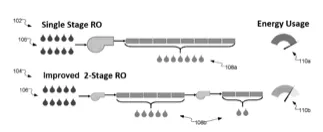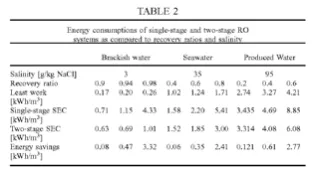2-Stage Reverse Osmosis with High Permeability Membranes for Desalination of Seawater at High Recovery
The technology proposes the use of two stage reverse osmosis (RO) systems for significant energy savings when purifying brackish water, seawater, and produced water.
Researchers
-
multi-stage reverse osmosis systems and methods
United States of America | Granted | 10,603,635
Figures
Technology
Design of the multi-stage RO system for water filtration
- Each stage has 1 feed stream inlet and 2 stream outlets: a permeate stream and a concentrate stream outlet
- The concentrate stream outlet of the first stage is coupled to the feed stream inlet of the second stage
- Pressure of the feed stream inlet in the first stage (P1) and pressure of the feed stream inlet in the second stage (P2), where P1 < P2 and pressures are configured so that flux of the permeate streams of the two stages has a minimizedspatial variance
- M number of reverse osmosis membranes in the first stage and N number of reverse osmosis membranes in the second stage, where M³N
Problem Addressed
Reverse osmosis (RO) is the leading method of desalination. RO provides secure water resources amidst the increasing demand for water, reduction of water resources, and increasing pollution of water. Many current water desalination systems use a single-stage RO system, which operates at high pressure through the whole system, and therefore results in high energy consumption and operating cost. Previously, multistage RO systems have been proposed to reduce energy, but with few practical realizations. This technology proposes an optimized, two-stage RO system, with identification of the parameters needed to achieve excellent energy savings. With seawater feed (32,000 ppm), energy savings up to 52% can be achieved at 90% recovery. At higher salinity feed (128,000 ppm), the two-stage RO system proves to be more beneficial. Energy savings can become significant at only 30% recovery, and savings increase to 24% at 65% recovery.
Advantages
- Cheaper operational cost – uses less energy to purify water than the single stage RO system
- Flexible set up – can adjust the distribution of RO membrane area between the stages and feed pressures at each of the stage to achieve energy savings
- Amenable to scaling up system throughout– can increase feed stream volume by including additional pressure vessels in parallel
- More energy savings with higher salinity feed – can also increase energy savings with higher permeability membranes and recovery rates
Publications
Quantum J. Wei, Ronan K. McGovern, John H. Lienhard V. "Saving energy with an optimized two-stage reverse osmosis system." Environmental Science: Water Research & Technology, 3, 659-670. (Published June 5, 2017). DOI: 10.1039/C7EW00069C.
License this technology
Interested in this technology? Connect with our experienced licensing team to initiate the process.
Sign up for technology updates
Sign up now to receive the latest updates on cutting-edge technologies and innovations.

